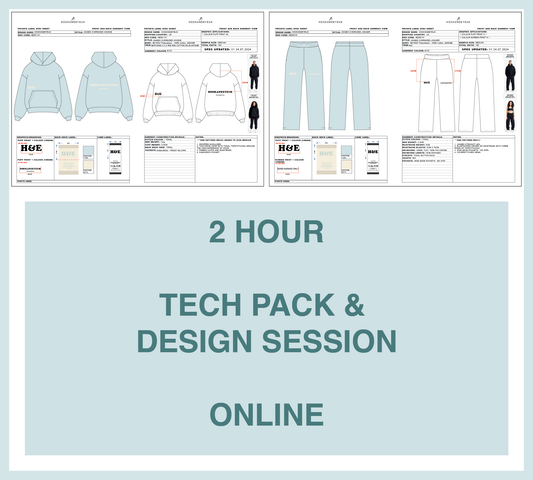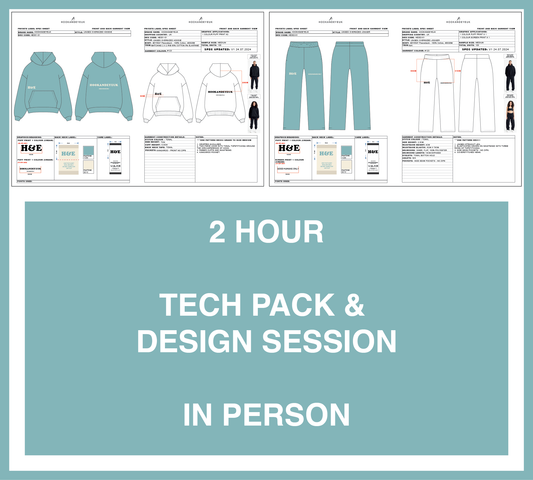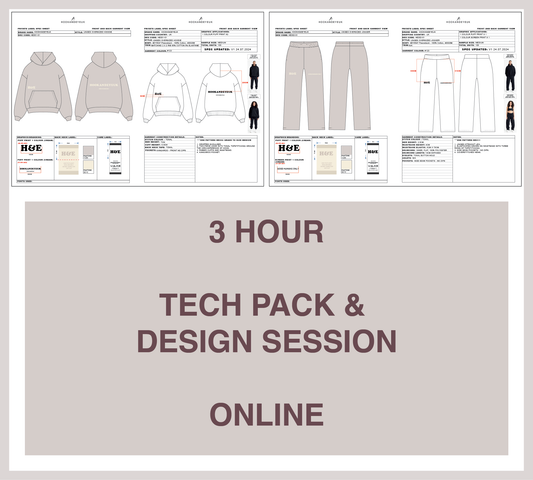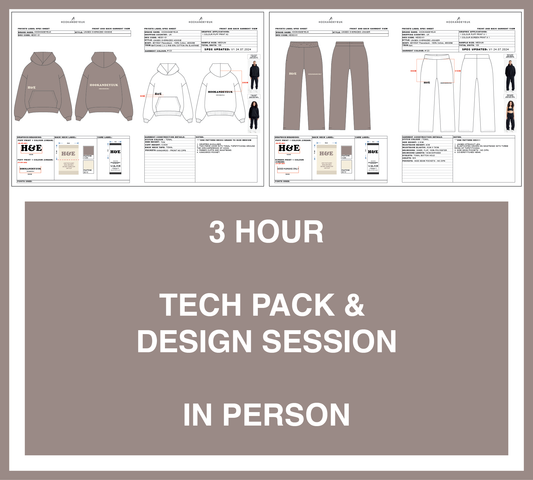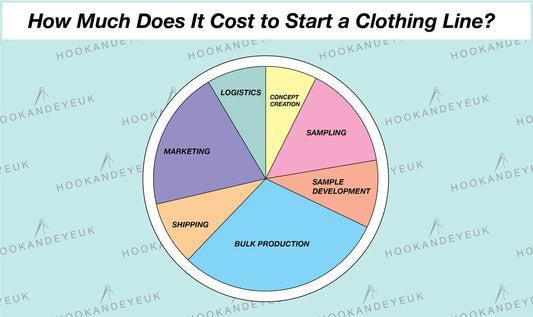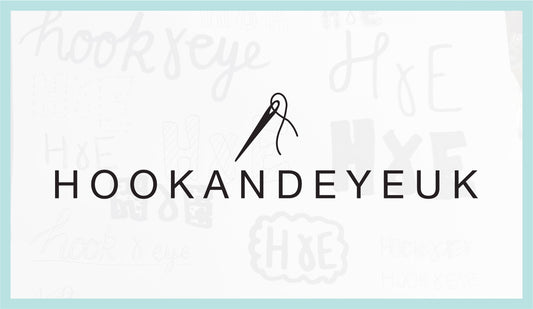The fashion industry has long been associated with rapid production cycles, cheap materials, and a throwaway culture. It generates an estimated 92 million tons of textile waste annually, with traditional manufacturing practices being a significant contributor. However, as awareness of environmental and social issues grows, the importance of sustainable clothing manufacturing has come to the forefront.
At Hook and Eye UK, our team of sustainable fashion experts has been developing innovative tech packs for sustainable fashion brands that address these challenges head-on. This article explores effective strategies for reducing waste throughout the manufacturing process—approaches we’ve refined through years of collaboration with sustainable fashion brands looking to minimise their environmental footprint while maintaining quality and profitability.
The Environmental Impact of Fast Fashion
The Growing Textile Waste Crisis
The fast fashion model thrives on overproduction and excessive sampling, leading to significant textile waste. In the US alone, according to government data, 17 million tons of textile waste were generated in 2018 alone, with a recycling rate of only 15%—down from 30% in the 1960s-1990s. The remaining 85% ends up in landfills or is incinerated.
Sustainable clothing manufacturing requires detailed technical documentation to ensure environmental standards are met throughout production. Without proper specifications, manufacturers often default to conventional practices that generate excessive waste.
To combat this issue, at Hook and Eye UK, we are actively exploring digital pattern cutting solutions as part of our sustainability goals. Digital pattern cutting technologies have revolutionised waste reduction in fashion manufacturing, typically reducing fabric waste by 15–20% compared to traditional methods.
By investing in durable materials and creating comprehensive tech packs, manufacturers can ensure that each piece is designed to last.
Water Pollution and Resource Consumption

The production of textiles is notorious for its contribution to water pollution. Harmful chemicals and dyes used in fabric manufacturing often end up in water bodies, contaminating ecosystems and harming aquatic life. The fashion industry consumes an estimated 141 billion cubic meters of water annually, making it one of the most water-intensive industries globally.
Choosing high-quality fabrics that are dyed using eco-friendly methods can significantly mitigate this issue. Consider options like organic cotton (using 91% less water than conventional cotton), recycled polyester (reducing energy consumption by up to 59%), or innovative alternatives like Tencel lyocell (produced in a closed-loop system that reuses 99.5% of chemicals and water).
At Hook and Eye UK, we support brands in making sustainable choices by offering guidance on incorporating eco-conscious fabrics, such as eco-friendly, recycled, organic, and other certified materials. Additionally, our bulk manufacturing unit operates on a +/-5% quantity system to help minimise fabric and garment waste, promoting efficient and responsible production.
Microplastic Pollution
Synthetic fibres, such as polyester and nylon, are prevalent in fast fashion garments. When washed, these materials shed microplastics that enter waterways and eventually the ocean, posing a threat to marine life and ecosystems. Studies show that 35% of microplastics in oceans come from textiles.
To address this problem, Hook and Eye UK’s sustainable tech packs provide detailed guidance on material selection. Helping brands transition to natural or semi-synthetic fabrics like organic cotton and hemp or Lyocell, rayon and Modal. These materials are not only fully or partially biodegradable but also produced through environmentally responsible processes that minimise waste and chemical use.
Carbon Emissions
The fashion industry is a significant contributor to global carbon emissions, primarily due to inefficient manufacturing processes. From energy-intensive production methods to long-distance transportation, the carbon footprint of clothing is substantial.
Brands can take proactive steps to reduce their emissions by sourcing materials locally and implementing energy-efficient practices. At Hook and Eye UK, we only source fabrics that are available locally to our factory, which optimises the sampling process, helping brands reduce carbon footprint.
The Social Impact of Sustainable Clothing Manufacturing
Addressing Poor Working Conditions
The drive for lower production costs often leads to poor working conditions in factories, particularly in developing countries. Workers are frequently subjected to long hours, low wages, and unsafe environments, all in the name of profit.

To promote ethical practices, consumers should demand transparency from brands regarding their supply chains. By choosing to support companies that prioritise fair labour practices and provide audit reports (preferably SEDEX), clothing brands and consumers can contribute to improving conditions for garment workers worldwide.
Ensuring Fair Wages
The pressure to keep prices low often results in workers receiving inadequate compensation for their labour. Many garment workers earn less than a living wage, making it difficult for them to support themselves and their families.
The Role of Consumers in Sustainable Fashion
Making Informed Choices
As consumers become more aware of the environmental and social implications of their purchases, they are increasingly seeking out sustainable options. According to recent studies, over 50% of consumers in the UK and Germany consider sustainability when making fashion purchases.
By choosing to buy from brands that prioritise ethical practices, shoppers can influence the market and encourage more companies to adopt sustainable methods. Look for brands that provide transparency about their manufacturing processes.
Embracing Minimalism
Adopting a minimalist approach to fashion can also contribute to sustainability. By purchasing fewer, high-quality items that are versatile and timeless, consumers can reduce their overall consumption and waste. The average garment is worn only 7-10 times before disposal—a statistic that highlights the need for a shift in consumer behaviour.

Supporting Local and Ethical Brands
Choosing to support local and ethical brands can have a positive impact on both the environment and the economy. By investing in companies that prioritise sustainable practices, consumers can help create a more equitable and responsible fashion industry.
Ready to Elevate Your Sustainable Production?
Sustainable clothing manufacturing is not merely a trend; it is a vital shift towards protecting our planet and ensuring social justice. By addressing the environmental and social challenges posed by fast fashion, we can create a more responsible industry that values quality, ethics, and sustainability.
At Hook and Eye UK, we specialise in creating comprehensive tech packs for sustainable fashion brands committed to ethical clothing production. Our technical documents and set protocols have helped numerous brands reduce sampling waste, ensure compliance with sustainability standards, and streamline their manufacturing processes.
As consumers, we have the power to drive this change by making informed choices and supporting brands that align with our values. Together, we can pave the way for a more sustainable future in fashion.
Need help implementing sustainable manufacturing practices?
Reach out to us today!
Hope you found this helpful,
H&E team :)


